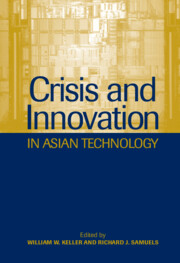Book contents
- Frontmatter
- Contents
- Figures and Tables
- Contributors
- Acknowledgments
- 1 Innovation and the Asian Economies
- 2 Japanese Production Networks in Asia: Extending the Status Quo
- 3 Crisis and Innovation in Japan: A New Future through Technoentrepreneurship?
- 4 Crisis, Reform, and National Innovation in South Korea
- 5 From National Champions to Global Partners: Crisis, Globalization, and the Korean Auto Industry
- 6 Crisis and Adaptation in Taiwan and South Korea: The Political Economy of Semiconductors
- 7 China in Search of a Workable Model: Technology Development in the New Millennium
- 8 Economic Crisis and Technological Trajectories: Hard Disk Drive Production in Southeast Asia
- 9 Continuity and Change in Asian Innovation
- Index
3 - Crisis and Innovation in Japan: A New Future through Technoentrepreneurship?
Published online by Cambridge University Press: 15 December 2009
- Frontmatter
- Contents
- Figures and Tables
- Contributors
- Acknowledgments
- 1 Innovation and the Asian Economies
- 2 Japanese Production Networks in Asia: Extending the Status Quo
- 3 Crisis and Innovation in Japan: A New Future through Technoentrepreneurship?
- 4 Crisis, Reform, and National Innovation in South Korea
- 5 From National Champions to Global Partners: Crisis, Globalization, and the Korean Auto Industry
- 6 Crisis and Adaptation in Taiwan and South Korea: The Political Economy of Semiconductors
- 7 China in Search of a Workable Model: Technology Development in the New Millennium
- 8 Economic Crisis and Technological Trajectories: Hard Disk Drive Production in Southeast Asia
- 9 Continuity and Change in Asian Innovation
- Index
Summary
The 1990s have been called Japan's lost decade. The decade began with the collapse of Japan's “bubble” as share prices plunged 40 percent in 1990, followed by a sharp decline in land prices. The heady spiral of the late 1980s “bubble economy” now became a vicious circle of bad debts and declining asset values. A string of high-profile corporate failures followed, and the decade closed without a resolution of Japan's financial crisis. Nor was the crisis limited to the financial sector. Major construction companies that had rashly offered developers collateral or guarantees during the bubble boom were kept alive only by massive injections of public funds in the form of stimulus packages.
Eventually, malaise hit Japan's dynamic manufacturing heartland. After a period of massive investment in the late 1980s a substantial cyclical adjustment was to be expected, but at the same time the cumulative hollowing-out effects of foreign direct investment (FDI) and difficulties in reorienting domestic operations toward higher-value-added, knowledge-intensive goods and services began to be felt, particularly in the small and medium-sized enterprise (SME) sector. Large trade surpluses continued, with new opportunities for equipment exports to power the growth in East Asian manufacturing prior to 1997, but there were now growing signs that many Japanese companies were falling behind in the fast-moving, fiercely competitive, global “new economy” that was emerging.
- Type
- Chapter
- Information
- Crisis and Innovation in Asian Technology , pp. 57 - 85Publisher: Cambridge University PressPrint publication year: 2003
- 5
- Cited by



